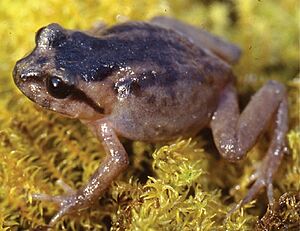Phrynopus kauneorum facts for kids
Quick facts for kids Phrynopus kauneorum |
|
|---|---|
 |
|
| Conservation status | |
| Scientific classification |
Phrynopus kauneorum is a special kind of frog that belongs to the family called Strabomantidae. This frog is found only in one specific area, which means it is endemic to the Andes mountains in Peru. You can find it near where it was first discovered in the Pachitea Province, and also in the Cordillera de Carpish. Both of these places are in the Huánuco Region of Peru. The frog's scientific name, kauneorum, was chosen to honor Andreas, Meeta, and Rebekka Kaune from Germany.
What Does It Look Like?
So far, scientists have only found female frogs and young frogs of this species. Adult female Phrynopus kauneorum can grow to be about 29 to 56 millimeters long from their nose to their rear end. This is quite big for a frog in this group!
This frog has a narrow and fairly short head. Its snout (the front part of its head) is short and rounded. It doesn't have a visible eardrum (called a tympanum), but it does have a clear fold of skin above where the eardrum would be.
Its fingers and toes don't have any webbing between them, nor do they have special skin fringes on the sides. The tips of its fingers and toes are a little bit swollen. The skin on its back is smooth. The frog's back is a bluish-gray color with dark brown spots and stripes. One stripe starts at its nose and goes over its upper eyelid all the way to its hip area. Another stripe runs along its side, starting behind its head and going to the middle of its body.
Where Does It Live and How Is It Doing?
The Phrynopus kauneorum frog lives on land, not in water. It makes its home in cloud forests found in the mountains, and also at the edges of these forests. However, you won't find it in farm fields. These frogs live at high elevations, from about 2,735 to 3,380 meters (about 8,973 to 11,089 feet) above sea level.
The biggest dangers to this frog are human activities like farming. Farmers growing potatoes and raising livestock (like cows or sheep) are changing the frog's natural home. Sadly, this frog is not known to live in any special protected areas, which means its habitat is not safe from these threats.


